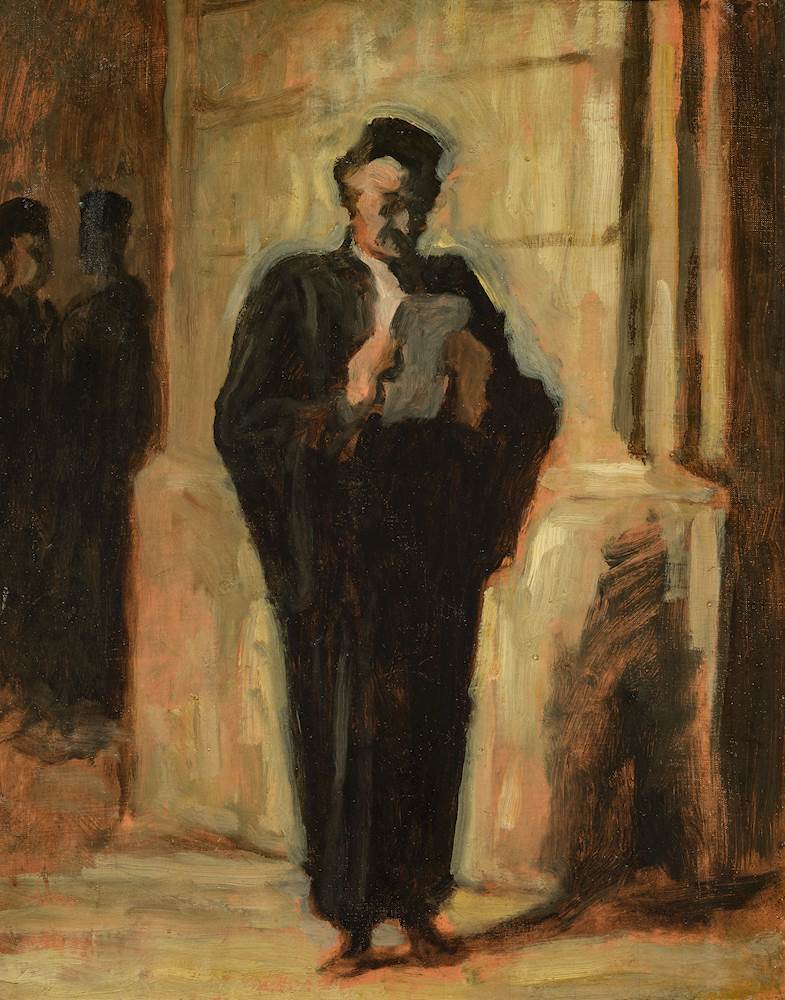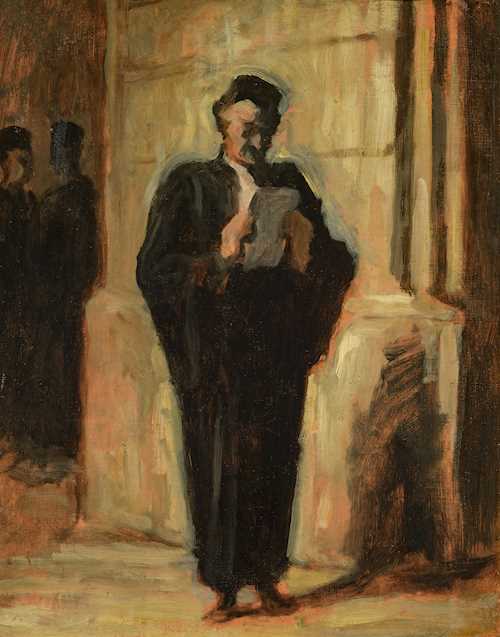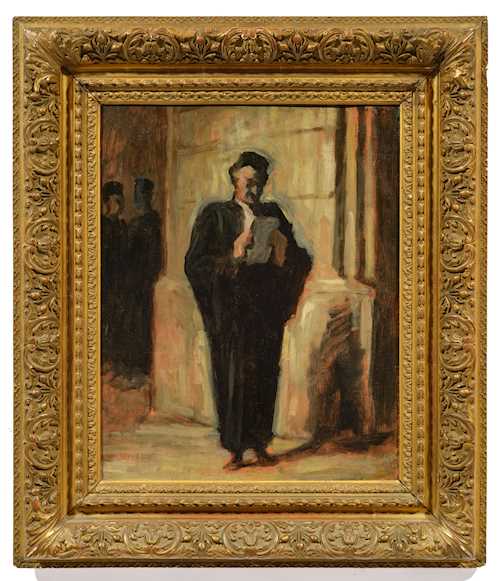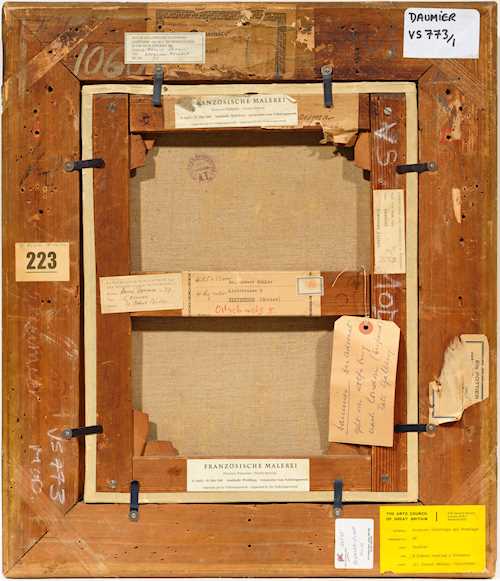
拍品 3244 - A210 19世纪的绘画作品 - Freitag, 20. September 2024, 04.00 PM
HONORÉ DAUMIER
(Marseille 1808–1879 Valmondois)
L'avocat lisant. Circa 1868–70.
Oil on canvas.
41.5 × 33 cm.
Provenance:
- Possibly Collection Jean-Baptiste-Camille Corot (1796–1875), Paris.
- Collection Arsène Alexandre (1859–1937), Paris.
- Collection Adolphe Tavernier (1853–1945), Paris.
- Sale Galerie Georges Petit, Collection Adolphe Tavernier, Paris, 6.3.1900, lot 14.
- Sale Hotel Drouot, Collection Adolphe Tavernier, Paris, 15.4.1907, lot 9.
- Collection Gallimard, possibly Paul Sébastien Gallimard (1850–1929), Paris.
- Possibly Galerie Druet, Paris.
- Collection Eduard Bühler (1862–1932), Winterthur.
- By descent, collection Dr. Robert Bühler (1902–1971), Winterthur (label verso).
- By descent, private collection, Switzerland.
Exhibited:
- Paris 1901, Exposition Daumier, par le Syndicat de la presse artistique, École des Beaux-Arts, May 1901, no. 75.
- St. Petersburg 1912, Exposition centennale de l’art français, Institut Français, no. 240, as "Avocat" (remnants of a label verso).
- Basel 1921, Exposition de peinture française, Société des Beaux-Arts, no. 46.
- Winterthur 1942, Der Winterthurer Privatbesitz I, Kunstmuseum Winterthur, 5.9.-1.11.1942, no. 77, as "L'avocat" (label verso).
- Paris 1946, La peinture française du XIXe siècle en Suisse, Gazette des Beaux-Arts, no. 38a.
- Paris 1953, Monticelli et le Baroque Provençal, Musée de l'Orangerie des Tuileries, June - September 1953, no. 29.
- Paris 1959, De Géricault à Matisse: Chefs-d’Oeuvre français des collections suisses, Petit Palais, no. 36 (label verso).
- Wolfsburg 1961, Französische Malerei von Delacroix bis Picasso, veranstaltet vom Volkswagenwerk, Stadthalle Wolfsburg, 8.4.–31.5.1961, no. 39 (label verso).
- London 1961, Daumier: Paintings and Drawings, Tate Gallery, June - July 1961, no. 86, as “A Lawyer reading a Document” (label verso).
- Schaffhausen 1963, Die Welt des Impressionismus, Museum zu Allerheiligen, 29.6.–29.9.1963, no. 31, as “Lesender Advokat” (label verso).
Literature:
- Erich Klossowski: Honoré Daumier, Munich 1923, 2nd edition, p. 97, no. 116.
- Eduard Fuchs: Der Maler Daumier, Munich 1927, p. 46, no. 22a. (with illustration).
- Jacques Lassaigne: Daumier, Paris 1938, p. 81 (with illustration).
- Jacques Lassaigne: Daumier, in: Jacques Lassaigne (ed.), Les Grands Maîtres de la Peinture, Paris 1946, p. 27 (with illustration).
- Jean Adhémar: Honoré Daumier, Paris 1954, pl. 21.
- Curt Schweicher: Daumier, London 1954, AB45pl. 24.
- Arts et Livres de Provence: Daumier, Marseilles 1955, p. 16.
- Robert Rey: Honoré Daumier, London 1966, p. 66 (with illustration on p. 67).
- Karl Eric Maison: Honoré Daumier. Catalogue raisonné of the paintings, watercolours and drawings, London 1968, p. 168, no. I-213, pl. 117.
‘L'avocat lisant’ by Honoré Daumier presents us with the image of a lawyer standing before a massive pillar inside the Palais de Justice in Paris, the setting for many of Daumier's depictions of lawyers. Clad in a black gown and engrossed in his documents, the lawyer appears to be reacquainting himself with his files just before the start of a trial.
Daumier skilfully reproduces the lawyer's posture, which exudes an air of ruthless severity and pretentious complacency, even beneath his ample gown. He also succeeds in lending the painting an uneasy undertone through the dramatic lighting and the resulting strong contrasts of light and dark. This is particularly evident in the face of the lawyer, which Daumier has distorted into an ominous-looking visage. The shadows of other lawyers can also be glimpsed in the background to the left. Are they possibly opponents of the lawyer here, or even schemers who are up to shady tricks behind his back?
This tension, together with the trenchant characterisation of the lawyer, makes the present work one of the most impressive oil paintings on canvas that Daumier created in the course of his artistic career, which spanned more than 50 years. ‘L'avocat lisant' is a striking example of Daumier's treatment of a key theme within his oeuvre, namely satirising representatives of the legal profession. This work is a departure, however, from his usual medium of lithography.
As a result of his criticism of society and the government in his art, Daumier was censored many times and was sentenced to six months in prison in 1832 for a satirical depiction of King Louis Philippe as Gargantua – the insatiable glutton and drunkard. This was one of the reasons why Daumier harboured a lifelong aversion to the French judiciary, but at the same time was fascinated by jurisprudence and its protagonists.
Honoré Daumier's satirical examination of the Parisian legal system of his time was not only based on his own experiences in court. After his release from prison, he also began attending public trials at the Palais de Justice, which was located not far from his studio on the Île Saint-Louis. Daumier succeeded in capturing the peculiarities of the Parisian courtrooms and commenting on them in a mordant fashion. He not only portrayed the sometimes absurd theatricality of the proceedings, but also addressed the abuse of power by bored or corrupt judges. In the 1840s and 1850s, for example, Daumier published several series of lithographs with titles such as ‘Gens de Justice’ (1845–1848) or ‘Physiognomie du Palais de Justice’ (1852), which were extremely popular, boosting his career as an artist and encouraging him to continue to pursue this subject matter. The repeated depiction of lawyers as merciless servants of a ruthless judiciary makes it clear that Daumier was critical of this profession, but at the same time also fascinated by it.
As well as enjoying an important standing in Daumier's oeuvre, the painting ‘L'avocat lisant’ also boasts an illustrious provenance and a long exhibition history. It is assumed that the work was once part of the collection of Jean-Baptiste Camille Corot (1796–1875), with whom Daumier maintained a close artistic friendship from around 1847. The painting also belonged for a time to the famous art critic Arsène Alexandre (1859–1937), who owned a dozen of Daumier's major works. The influential Bühler family of industrialists from Winterthur also owned the painting and were responsible for the work being shown at numerous important exhibitions throughout Europe, particularly in the middle of the 20th century. This exceptional provenance emphasises the outstanding quality of the artwork on offer here.
Daumier skilfully reproduces the lawyer's posture, which exudes an air of ruthless severity and pretentious complacency, even beneath his ample gown. He also succeeds in lending the painting an uneasy undertone through the dramatic lighting and the resulting strong contrasts of light and dark. This is particularly evident in the face of the lawyer, which Daumier has distorted into an ominous-looking visage. The shadows of other lawyers can also be glimpsed in the background to the left. Are they possibly opponents of the lawyer here, or even schemers who are up to shady tricks behind his back?
This tension, together with the trenchant characterisation of the lawyer, makes the present work one of the most impressive oil paintings on canvas that Daumier created in the course of his artistic career, which spanned more than 50 years. ‘L'avocat lisant' is a striking example of Daumier's treatment of a key theme within his oeuvre, namely satirising representatives of the legal profession. This work is a departure, however, from his usual medium of lithography.
As a result of his criticism of society and the government in his art, Daumier was censored many times and was sentenced to six months in prison in 1832 for a satirical depiction of King Louis Philippe as Gargantua – the insatiable glutton and drunkard. This was one of the reasons why Daumier harboured a lifelong aversion to the French judiciary, but at the same time was fascinated by jurisprudence and its protagonists.
Honoré Daumier's satirical examination of the Parisian legal system of his time was not only based on his own experiences in court. After his release from prison, he also began attending public trials at the Palais de Justice, which was located not far from his studio on the Île Saint-Louis. Daumier succeeded in capturing the peculiarities of the Parisian courtrooms and commenting on them in a mordant fashion. He not only portrayed the sometimes absurd theatricality of the proceedings, but also addressed the abuse of power by bored or corrupt judges. In the 1840s and 1850s, for example, Daumier published several series of lithographs with titles such as ‘Gens de Justice’ (1845–1848) or ‘Physiognomie du Palais de Justice’ (1852), which were extremely popular, boosting his career as an artist and encouraging him to continue to pursue this subject matter. The repeated depiction of lawyers as merciless servants of a ruthless judiciary makes it clear that Daumier was critical of this profession, but at the same time also fascinated by it.
As well as enjoying an important standing in Daumier's oeuvre, the painting ‘L'avocat lisant’ also boasts an illustrious provenance and a long exhibition history. It is assumed that the work was once part of the collection of Jean-Baptiste Camille Corot (1796–1875), with whom Daumier maintained a close artistic friendship from around 1847. The painting also belonged for a time to the famous art critic Arsène Alexandre (1859–1937), who owned a dozen of Daumier's major works. The influential Bühler family of industrialists from Winterthur also owned the painting and were responsible for the work being shown at numerous important exhibitions throughout Europe, particularly in the middle of the 20th century. This exceptional provenance emphasises the outstanding quality of the artwork on offer here.
DAUMIERS SCHATTENANWALT
"DER KÜNSTLER ERZÄHLT UNS HIER EINE GESCHICHTE".
Die Beweggründe und Techniken hinter diesem faszinierenden Werk von Honoré Daumier werden von Hagen Garhöfer und Karoline Weser erläutert.
CHF 150 000 / 200 000 | (€ 154 640 / 206 190)



